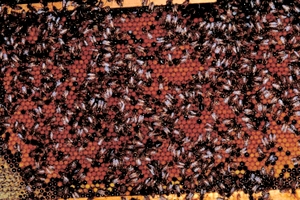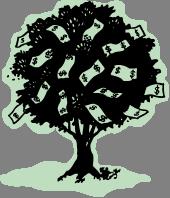Ecosystem Restoration Benefits
Benefits
Ecosystem Services
The substantial benefits of ecosystem restoration are well documented and are most easily described in terms of services provided. "Ecosystem services are the processes by which the environment produces resources…such as clean water, timber, habitat for fisheries, and pollination of native and agricultural plants" (ESA). Every ecosystem produces a unique set of resources. By protecting and enhancing ecosystems through preservation and restoration, these resources are also preserved. Below is a sample of ecosystem services.
Table 2: Ecosystem Services
Source: USEPA and Ecological Society of America
|
Ecosystem Services |
|
|
|
|
|
|
|
|
|
|
|
|
|
|
|
|
|
 |
|
Honey Bees, Apis mellifera-on comb, Dick Todd |
Ecosystem services support terrestrial, aquatic, and human communities that each depend on the vitality of these services to provide nutrition as well as habitat stability for our homes and businesses(Chicago Region Biodiversity Council, 1999). Although some of the above services are observable, most services are so seamlessly performed that they receive little human acknowledgement. For example one third of all human food originates from plants pollinated by over 100,000 wild pollinators including bats, bees, flies, moths, beetles, birds and butterflies (ESA). Without this service, we could expect a substantial decrease in food variety and nutritional intake in addition to further modifications within those ecosystems. The Midwest is already experiencing a decline in wild pollinators. Wisconsin, Minnesota, Ohio, Iowa and Michigan have already reported decreased numbers of honey bee colonies. In addition to making millions of pounds of honey each year, the U.S. honey bee population (140 billion) is responsible for pollinating our healthiest nuts and fruits crops including almonds, apples, broccoli, cranberries, strawberries, alfalfa, soybeans, and cotton (McFadden, 2007). Companies like Haagen-Dazs are beginning to realize their reliance on ecosystems services and the need to preserve the bee population their products depend on. For more information click here.
Economic Benefits
 Although the above example demonstrates only a small portion of the total benefits of ecosystem services, in our society it is important to quantify the economic costs and benefits of a strategy as well. Although this applies well in the business world, it is more difficult (and some would argue morally wrong) to place a dollar value on the natural environment and the services it provides. What is the value of one acre of prairie? Is it $1000, $2000, invaluable? This difficulty extends to placing monetary value on ecosystems and therefore quantifying the economic benefits of ecosystem restoration. However currently there is research and case studies that attempt to estimate and assign monetary values to ecosystems while incorporating avoided economic costs that already have "value" in our society. For example, it is estimated that honey bees are responsible for pollinating a total of $14 billion of seeds and crops annually in the U.S. (Barrionuevo, 2007). The act of pollination itself has an avoided cost value of $4-$6 billion because the service is currently provided for "free" by natural processes. If ecosystems are further degraded, many of these "free" services will no longer exist. This will result in more costly manmade replacements when and if possible (ESA). Healthy ecosystems, which are currently undervalued, have still been shown to economically outperform man-made solutions in terms of the services they provide. In some cases ecosystems have in essence become cost-effective enough to be preserved. This type of research and effort has caught the attention of conservationists as well as the business community and stands to challenge conventional standards of assessing value as well as serving as a tool to more comprehensively understand the full impacts of our actions and decisions (Boyd 2007, 29).
Although the above example demonstrates only a small portion of the total benefits of ecosystem services, in our society it is important to quantify the economic costs and benefits of a strategy as well. Although this applies well in the business world, it is more difficult (and some would argue morally wrong) to place a dollar value on the natural environment and the services it provides. What is the value of one acre of prairie? Is it $1000, $2000, invaluable? This difficulty extends to placing monetary value on ecosystems and therefore quantifying the economic benefits of ecosystem restoration. However currently there is research and case studies that attempt to estimate and assign monetary values to ecosystems while incorporating avoided economic costs that already have "value" in our society. For example, it is estimated that honey bees are responsible for pollinating a total of $14 billion of seeds and crops annually in the U.S. (Barrionuevo, 2007). The act of pollination itself has an avoided cost value of $4-$6 billion because the service is currently provided for "free" by natural processes. If ecosystems are further degraded, many of these "free" services will no longer exist. This will result in more costly manmade replacements when and if possible (ESA). Healthy ecosystems, which are currently undervalued, have still been shown to economically outperform man-made solutions in terms of the services they provide. In some cases ecosystems have in essence become cost-effective enough to be preserved. This type of research and effort has caught the attention of conservationists as well as the business community and stands to challenge conventional standards of assessing value as well as serving as a tool to more comprehensively understand the full impacts of our actions and decisions (Boyd 2007, 29).
Land Use Planning
Additionally ecosystem preservation and restoration can also be a beneficial land use decision for municipalities and counties. Local sources state that ecosystem restoration sites pay for themselves along with agricultural, open space, commercial and industrial sites in terms of municipal resources needed. It tends to be residential sites, with their necessity for city services (fire, water, streets, etc) that create a financial burden on municipalities.